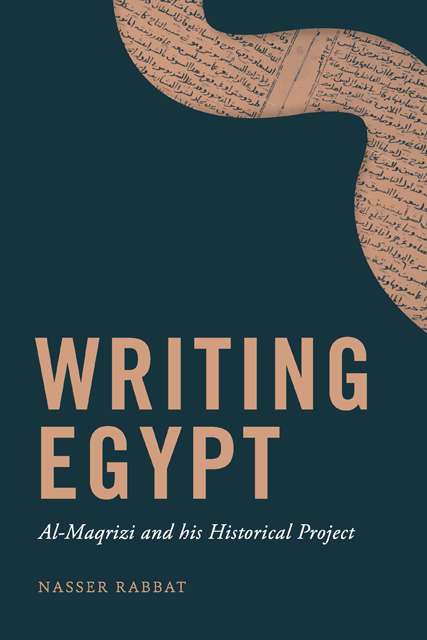Book contents
- Frontmatter
- Contents
- Preface
- List of Short References to Frequently Cited Primary Sources
- List of Abbreviations
- Notes on Transcription and Dates
- Introduction: A Singular Mamluk Historian
- Part 1 The Life of al-Maqrizi
- Part 2 The Writings of al-Maqrizi
- Part 3 The Afterlife of al-Maqrizi’s Writing
- In the Guise of a Conclusion: Becoming the Greatest Historian of Egypt
- Bibliography
- Index of Books Cited in the Text
- General Index
4 - The Khitat: History and Belonging
Published online by Cambridge University Press: 02 June 2023
- Frontmatter
- Contents
- Preface
- List of Short References to Frequently Cited Primary Sources
- List of Abbreviations
- Notes on Transcription and Dates
- Introduction: A Singular Mamluk Historian
- Part 1 The Life of al-Maqrizi
- Part 2 The Writings of al-Maqrizi
- Part 3 The Afterlife of al-Maqrizi’s Writing
- In the Guise of a Conclusion: Becoming the Greatest Historian of Egypt
- Bibliography
- Index of Books Cited in the Text
- General Index
Summary
Al-Maqrizi’s considerable historical oeuvre on Islamic Egypt appears to us today to have been systematically structured to cover every aspect of its history from the perspective of a medieval Muslim scholar: its annals, important and remarkable people, tribes, cities, countryside, the Nile, and deserts, wonders and religious merits, glorious days and gloomy ones, and its changing relationships to its larger Islamic and world context. This large set of topics, each treated under its specific title or titles written over more than thirty-five years, was nonetheless intertwined with the writing of the Khitat, which was al-Maqrizi’s first true introduction to history writing after a small number of short, exhortative or advisory treatises. The separate titles proceeded in an almost chronological order, from the pre-Islamic history to the contemporary affairs of the country, in a manner that seems to have reflected the stages of the Khitat’s gestation. This rationalized and long project was interspersed with shorter treatises, which can be seen as the separate exercises of a solitary man who may have wanted every now and then to take a break from the rather rigid writing program he imposed on himself. They may also have been commissioned by kind patrons as means of providing indirect financial support to the otherwise impoverished and proud scholar. This at least appears to be the case with one of al-Maqrizi’s most unusual treatises, al-Ishara wa al-Ima’ ila Hall Lughz al-Ma’, completed on the 14th of Muharram 823/30 January 1420, during the early part of his retreat, in which he mentions that he composed it in compliance with the al-ishara al-karima (noble wish), although he does not say anything about the identity of that patron, or any possible patron of any of his other treatises for that matter.Given the date of the treatise, however, this patron was most probably one of the powerful Nasrallah trio, Muhibb al-Din, Badr al-Din, and Salah al-Din, all of whom are mentioned repeatedly and appreciatively by al-Maqrizi in his Suluk.
Al-Maqrizi was already a seasoned administrator and a known scholar with a number of short treatises to his credit when he decided to withdraw from public life and devote himself entirely to history writing.
- Type
- Chapter
- Information
- Writing EgyptAl-Maqrizi and his Historical Project, pp. 154 - 202Publisher: Edinburgh University PressPrint publication year: 2023

